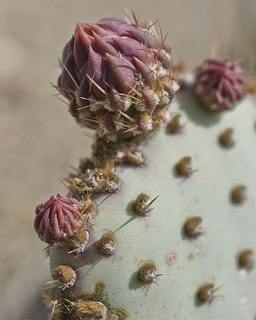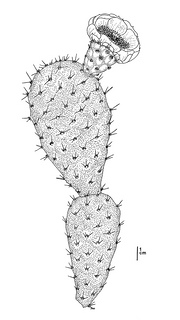(Opuntia basilaris var. treleasei)
 Opuntia basilaris var. treleasei. CDFW photo by Jeb Bjerke.
Opuntia basilaris var. treleasei. CDFW photo by Jeb Bjerke.
 Opuntia basilaris var. treleasei. CDFW illustration by Mary Ann Showers. (Click to enlarge)
Opuntia basilaris var. treleasei. CDFW illustration by Mary Ann Showers. (Click to enlarge)
Bakersfield cactus is a California endangered plant species, which means that killing or possessing the plant is prohibited by the California Endangered Species Act (CESA). Bakersfield cactus can grow to be approximately 40 cm tall and flowers in March and April. Bakersfield cactus once formed extensive colonies in the area around Bakersfield, California, extending up the Kern River Canyon to the northeast, through the Caliente Creek drainage to the southeast, and to the Tejon Hills about 20 miles to the south. Much of the historical habitat for the species has been destroyed and fragmented by impacts associated with human activities such as development, agricultural conversion of land, overgrazing, and oil field development. Bakersfield cactus continues to be threatened by the factors above, and by off-road vehicle use, dumping, invasive plant species, air pollution, and maintenance of roads and other infrastructure, and is expected to be further threatened in the future by climate change and possibly the Opuntia-killing cactus moth (Cactoblastis cactorum), which is slowly moving westward from Florida. Bakersfield cactus is also listed as an endangered species under the federal Endangered Species Act, and at the time of this page’s posting, the California Natural Diversity Database reported 37 occurrences of this species that are presumed to still exist.
In the face of these threats decisive action must be taken to conserve and recover Bakersfield cactus. The permanent protection and management of remaining Bakersfield cactus populations is one of the species’ greatest conservation needs, and most of these remaining populations occur on privately owned land. Approximately 83 percent of existing Bakersfield cactus habitat is unprotected and only four entire populations and part of eight others are permanently conserved. In addition, landowners provide some protection of 10 populations, but these protections are not guaranteed in perpetuity. Populations should be protected from dumping and off-road vehicle use with fencing, appropriate signage, and enforcement. Invasive vegetation should also be managed and controlled within and around populations, and efforts to increase the number of populations and the number of plants should be made. Outreach and education programs should be provided and funding should be sought to implement the necessary conservation actions.
CDFW has participated in the following Bakersfield cactus study with support via the federal Cooperative Endangered Species Conservation Fund also known as “Section 6”:
CDFW may issue permits for Bakersfield cactus pursuant to CESA, and you can learn more about the California laws protecting Bakersfield cactus and other California native plants. Populations of Bakersfield cactus occur in CDFW’s Central Region. More information on Bakersfield cactus is also available from the United States Fish and Wildlife Service Species Profile for Bakersfield Cactus.
Updated 1/17/2013